No longer should anyone be thinking a rabbit hutch is enough, it’s not! All rabbits need housing that will allow them room to jump and run about in, room to stretch out and relax, somewhere to feel safe and somewhere snug to sleep. This section gives plenty of great rabbit home ideas, different housing types and how to fill them with accessories and toys to keep your bunny safe and entertained too!
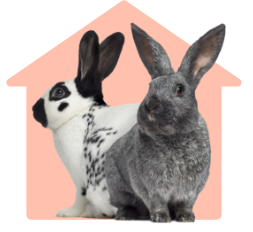
In this section
Indoor housing ideas
What type of housing is best?
There are lots of different ways to house your bunnies indoors. Every bunny & every house is different. The most important thing is to provide a home that suits your bunnies and that keeps them safe. As long as they have lots of space, a quiet place to retreat to and plenty of toys, then you will have some very happy bunnies.
Lots of people have house rabbits that have the run of the house, along with an area to call their own. This is a great option for house bunnies but it all depends on the fact that your bunnies are well trained enough for this. Safety comes first & if you do not trust your bunnies to be left alone or if you have other pets then it is best to have them safely enclosed in an area for when you are not there.
Puppy pens
A great set up for a house rabbit is an open top puppy pen. They can be spacious and airy so the rabbit does not feel enclosed as much as they would in a cage.
Pens are also great as you can move them around and change the shape of them to suit your space and this adds variety. They also look good and do not clutter a room.
Please note: If you have other animals then you will need a pen that comes with a top for added security.
The best height to get is 35in. This will stop any escapes if your bunny was thinking of jumping over the top. Just be careful to not place any items next to the edges that your bunny could climb up on and make it easy for them to jump out.
Although puppy pens are a decent size it is still very important that your bunnies get their daily exercise. If you want to let your rabbit have free range exercise around the house, increase the free range area gradually until they are trained. Also decide beforehand what rooms are out of bounds and take precautions for this so your rabbit understands.
Other indoor accommodation types
- The RWAF recommended space needed for a pair of average size rabbits is a single enclosed area of at least 3m x 2m by 1m high. This can include the sleeping quarters, and makes up a footprint (accessible area of the ground or floor) of 3m x 2m. They will also need an exercise area.
- Dog crates are not big enough on their own so you will need to provide a run also. A good idea is to attach a puppy pen to the dog crate to allow for the extra space. Please note some dog crates can also be difficult to clean out.
- Indoor rabbit/guinea pig cages – the size of these are usually too small on there own, so to add a puppy pen as additional space would be a great idea. Beware of indoor rabbit cages with a step up/over at the entrance as they are not rabbit friendly. Old & young rabbits struggle to get in and out of them and if your rabbit needs to sprint in it at speed, if something panics them, they could injure themselves. The plastic indoor hutches/cages are not rabbit friendly and also not big enough.
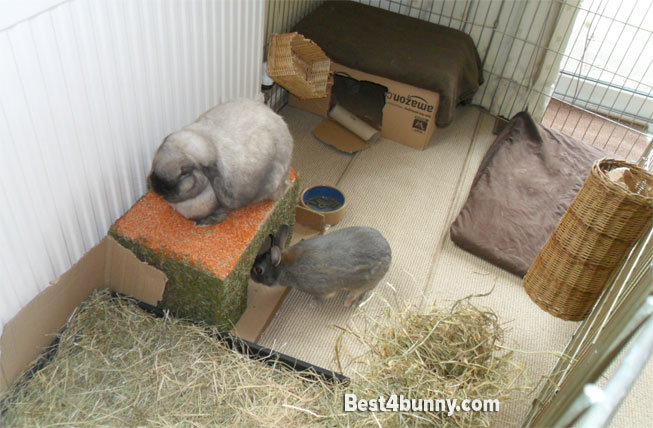
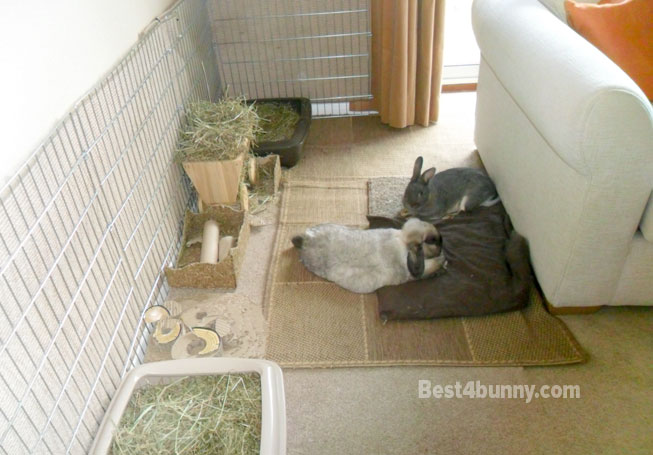
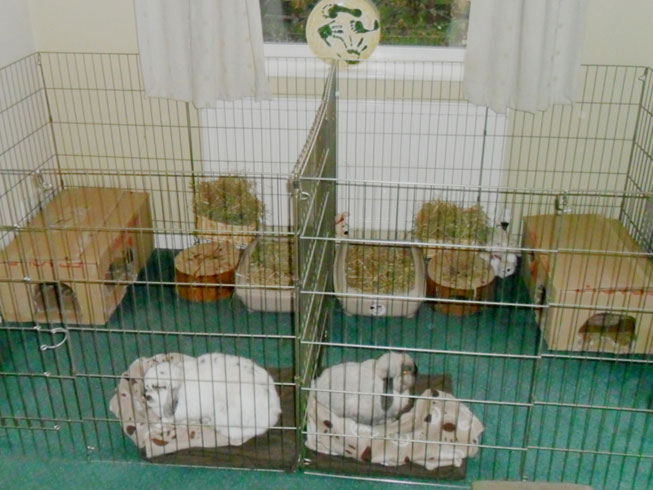
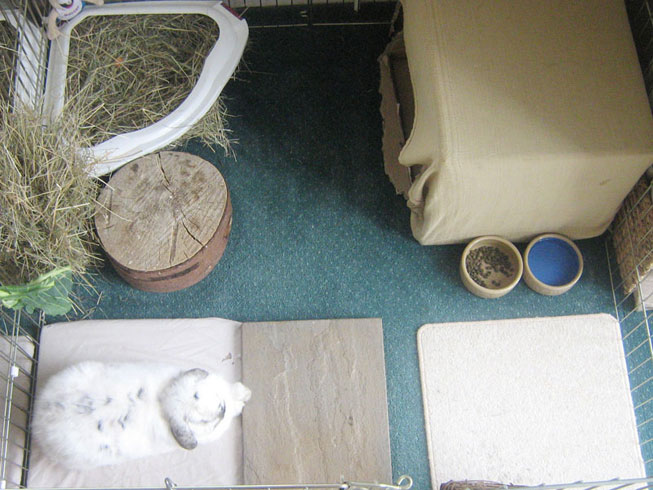
Where to place your rabbit’s indoor home
- Area needs to be quiet/cool/away from draughts/away from heaters.
- Near a window for natural light.
- Near patio doors is a good idea so they can look out. (But be aware they can easily get spooked by predators in the night walking by patio doors, block the view at night with a curtain)
- Make sure they are not right next to any radiators.
It is a good idea to have thermostats added to your radiators so you can control the temperature of radiators in the same room as the bunnies.
For advice on how to bunny proof your house see Bunny behaviour – Indoors & house proofing.
For more advice on house training, see Bunny behaviour – Training bunny.
Outdoor housing ideas
The list is endless to what people are doing this day & age to provide their bunnies with the most luxurious suitable accommodation. The more people that are made aware of these ideas the more chance we will have of ridding rabbits kept cruelly in small cramped cages/hutches.
Some great ideas
- Outhouses converted to bunny homes with secure outside run attached
- Hutches placed within an aviary enclosure
- Dog kennels with the runs attached (these come in all shapes and sizes).
- Playhouses with secure outside run attached
- Large 6ft, 7ft or 8 ft hutches, 3ft deep and 3ft high with runs attached
- Shed with secure outdoor run attached.
Thank you to the rabbit residence rescue for the use of their pictures.
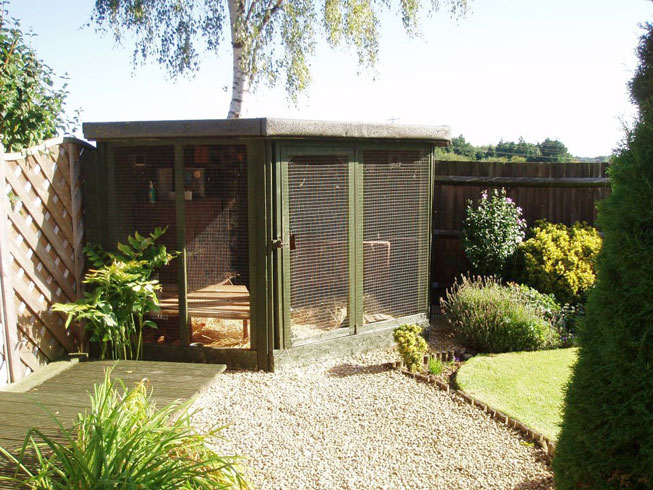
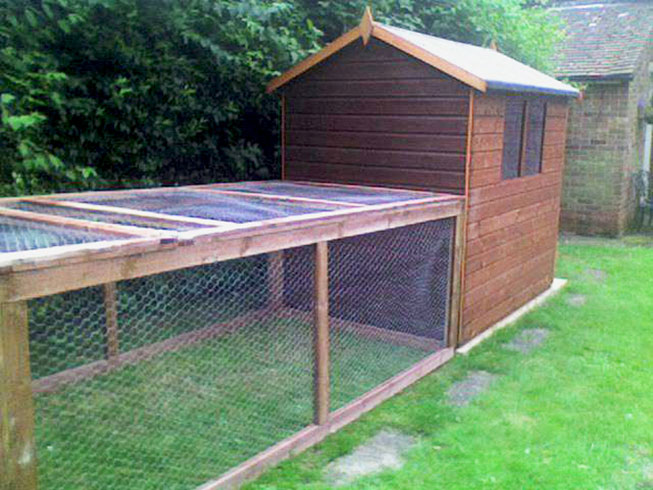
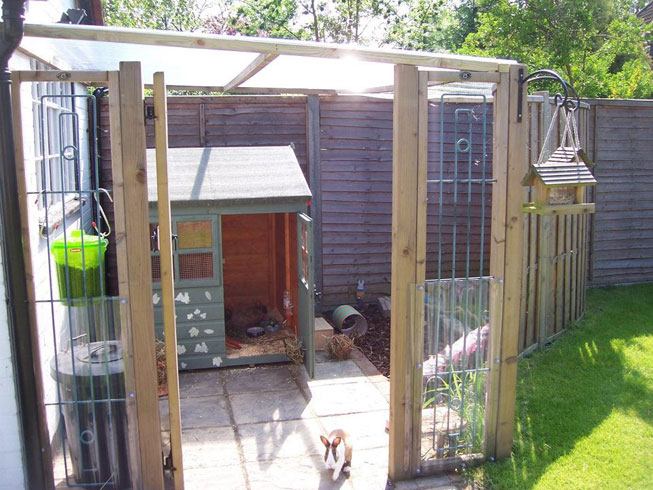
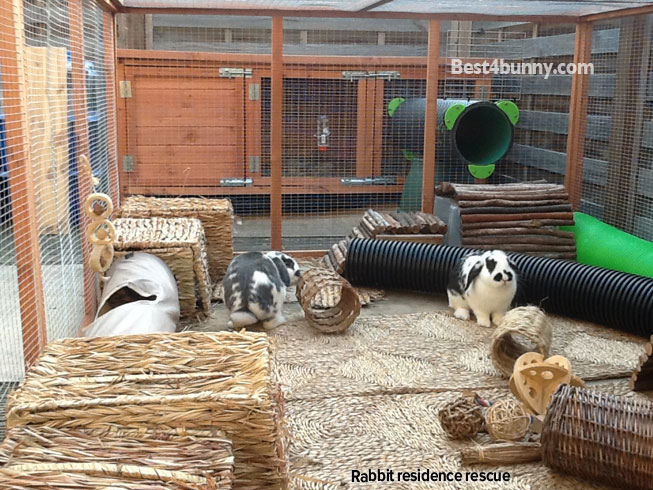
If you are using a hutch only, then the recommendation for a pair of average size rabbits is a single enclosed area of at least 3m x 2m by 1m high. This can include the sleeping quarters, and makes up a footprint (accessible area of the ground or floor) of 3m x 2m. They will need an additional area for their exercise time. If you cannot attach a run direct to the hutch you could attach a runaround tunnel to link them from afar. Always place runs on concrete slabs to stop your rabbit digging out and to stop a predator digging in!
To make a pop up exercise area quickly for your rabbit you can use metal puppy pens as they are reasonably priced and great as they fold away when they are not being used and you can set them up anywhere. You can also buy more than one and make the pen even bigger. Please note: Make sure you supervise your rabbit at all times whilst they are exercising in these as they are in no way predator proof. Never leave them unattended.
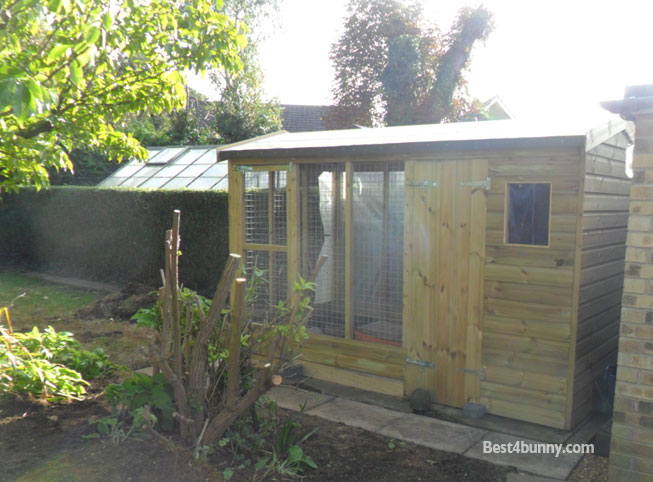
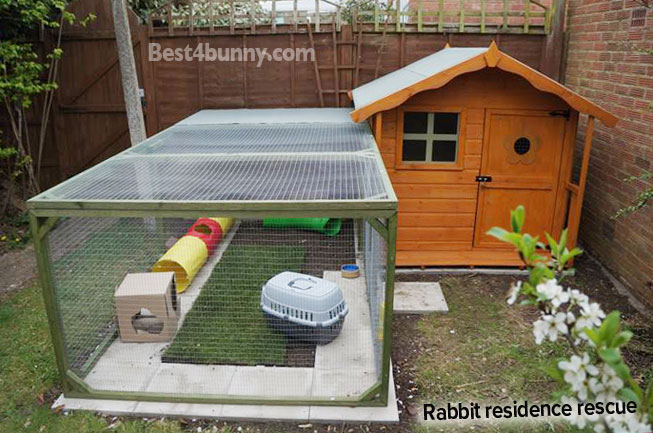
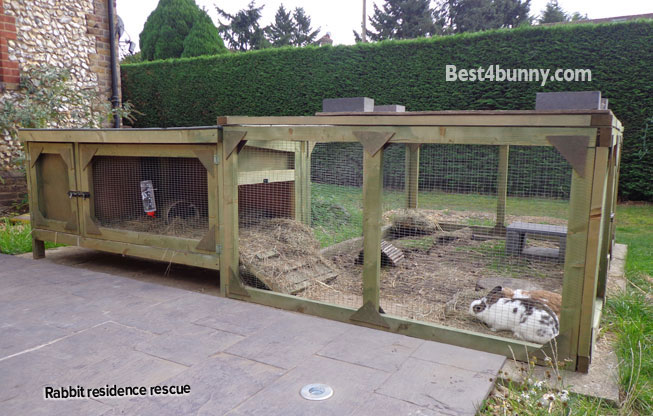
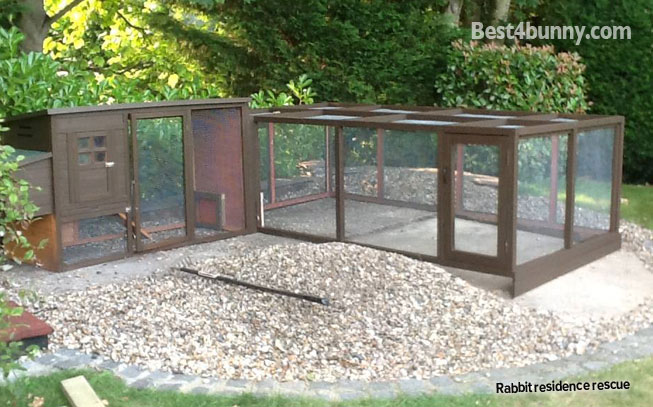
Building your own enclosure
Remember the bigger the better for your rabbits and for you too, as it will be easier to clean out and you will get so much more entertainment watching your rabbits binky and run at great speeds around an enclosure that is big enough to allow them to do this.
The Rabbit Welfare Association (RWFA) size reccommendations:
- Recommendation for a pair of average size rabbits is a single enclosed area of at least 3m x 2m by 1m high. This can include the sleeping quarters, and makes up a footprint (accessible area of the ground or floor) of 3m x 2m.
- Ply wood and pine are safe woods: two types of pine wood, Whitewood and Redwood untreated.
- Treat with Cuprinol.
- Galvanised wire no bigger than 1inch by half inch should be size of squares. Never use wiring with large squares as rats and stoats could get in or cats/foxes could injure your bunny through these gaps. Prime welded wire mesh is best.
[adsanity align=’alignnone’ id=63]
Predator proofing
It is extremely important that all enclosures are made predator proof.
- You need to place your rabbit’s accommodation on slabs to avoid a fox digging in or your rabbit digging out.
- Make sure doors are secure with bolts at the top and bottom for extra security.
- Always provide hideouts – safe places to hide when they get spooked or feel threatened
- Tunnels are good for hide outs.
- Place boards at the front of your enclosure to add extra privacy & to help stop your rabbit getting easily spooked.
Weather Proofing
Finding a good rabbit savvy vet is essential. Rabbits are classed as exotic pets, so look for a vet that specialises in exotic animals. A good Vet should ideally check your rabbits heart rate, teeth, ears, eyes, bottom area, stomach and weight on every visit. With a sick rabbit, your vet will ask you questions like:
- When did they last eat?
- When did they last poop/ What did it look like?
- What are the symptoms that have alerted you?
- What difference in behaviour have you seen?
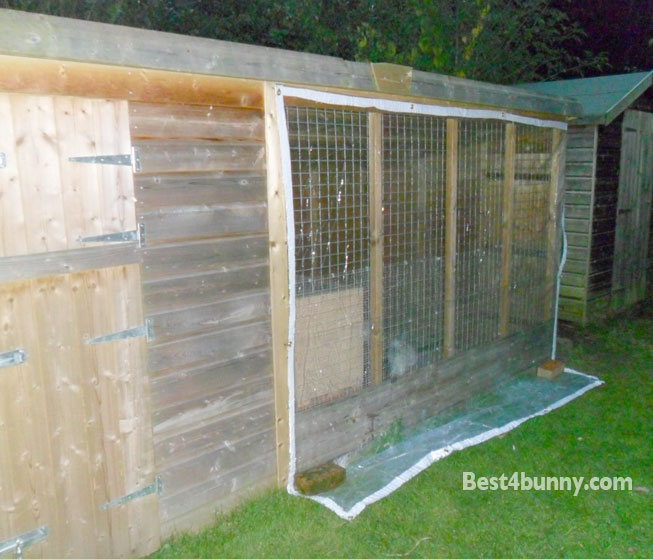
[adsanity align=’alignnone’ id=63]
Creating the right environment
Whatever you chose to place in your rabbits enclosure, by rearranging the set up every now and then your bunny will think they have a whole new home to explore and this keeps them entertained!
Nest boxes/hideouts
Nest boxes within an enclosure make an ideal place for your rabbit to hide in or to keep warm in. They may also enjoy jumping on top of them.
The only good thing about those horrible small rabbit hutches sold in pets shops is you can use them within their accommodation set ups as cosy hideouts and for your bunny to climb on.
Stuff them full of hay in the winter and your bunny will love it. You could also make them even cosier by putting cardboard around the inside edges in the winter for extra insulation.
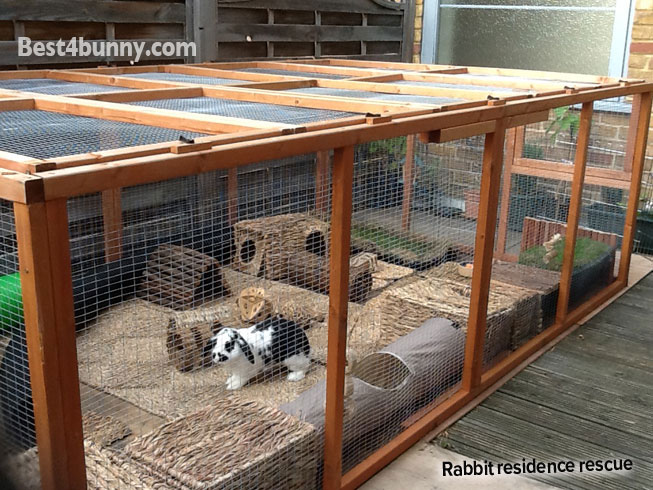
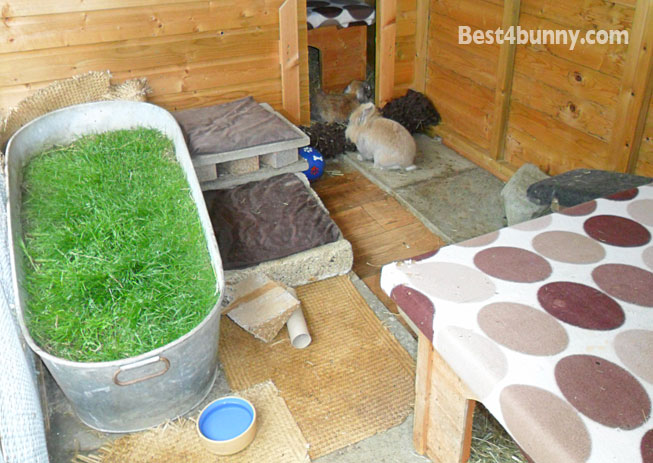
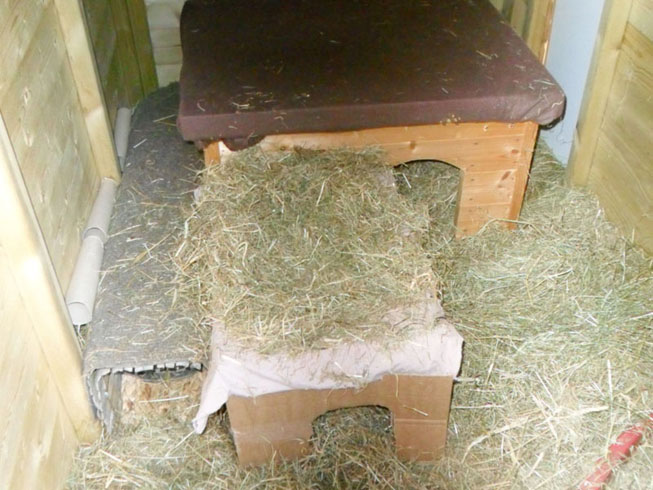
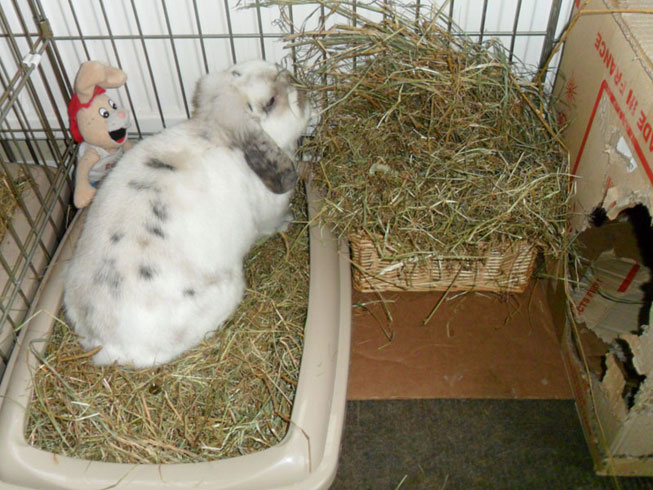
Cardboard boxes
Cardboard boxes provide hours of entertainment & also provide somewhere for your rabbit to run into when they feel threatened.
Carve a doorway or two into the cardboard box so it resembles a little hideout house for your rabbit and place some hay and toys inside the cardboard box for extra fun.
The double walled cardboard boxes are best as they are more sturdier and will last that bit longer. You can order them in bulk at quite a reasonable price off the internet. Just check they don’t have staples in.
Hay racks
Place hayracks next to the litter trays to allow your rabbits to eat as they poop which all rabbits love to do and it encourages hay eating.
Anything that has holes in that can be stuffed with hay and will not harm your rabbits health can be used as a hay rack. The plastic carrier bag holders are a big favourite as are hanging baskets or just make a tunnel shape out of some galvanised wire and stuff that full of hay. Please watch any items that have large enough gaps in where they could catch their feet or heads. Always make sure the gaps are stuffed well with hay & they are placed high enough so your rabbit cannot jump into them.
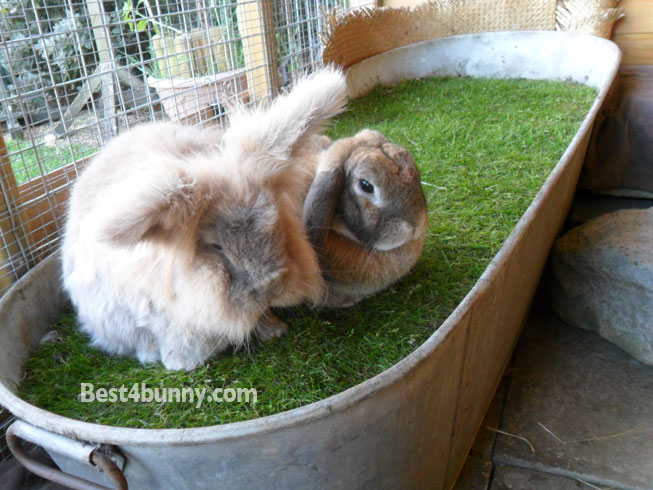
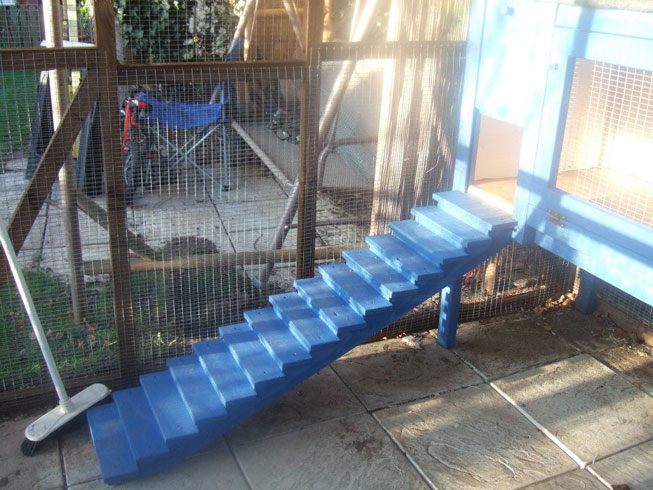
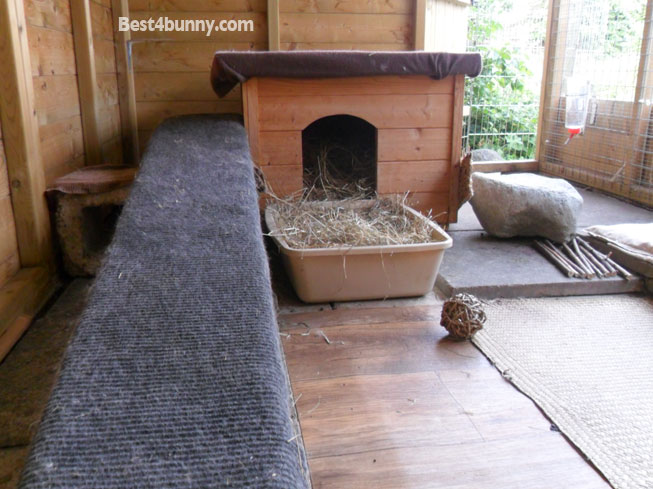
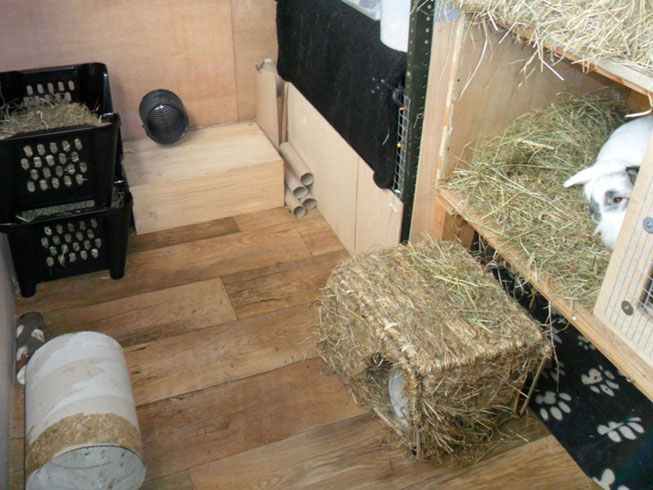
Cheap comfy beds
Rabbits love comfort and a good cheap way of providing a pet bed is use a sample square of carpet (you can get these from most carpet shops for about 50p) or a flat chair cushion and place them in cotton pillow cases. Pillow cases are also cheap to buy and easy to wash. In the winter include a little blanket also. Rabbits love to dig at blankets and push them about but if your rabbit starts to chew at the blanket then remove it.
Litter trays and dig trays
Litter trays come in all shapes and sizes, but the bigger the tray the more hay you can put in to encourage your rabbit to eat hay while they poop. Under bed storage containers, seed trays and drip/gravel trays can be ideal as they do come in big sizes and all kinds of shapes and are cheaper to buy than some actual litter trays.
Trays filled with soil, child friendly sand or grass turf are a great way to add some natural areas to your rabbits enclosure and create lots of fun.
Make ramps safe
Make ramps safe and rabbit friendly by covering with carpet or a mat. Or add bits of wood to create a step effect and allow your rabbit to have more grip on the ramp. Never position a ramp too steep as this could result in an injury. You can place a sturdy item like a large garden stone or brick underneath the lower end to raise the ramp up so its not so steep.
Flooring
All flooring for inside and outside accommodation should be non slip to avoid your rabbit injuring themselves.

